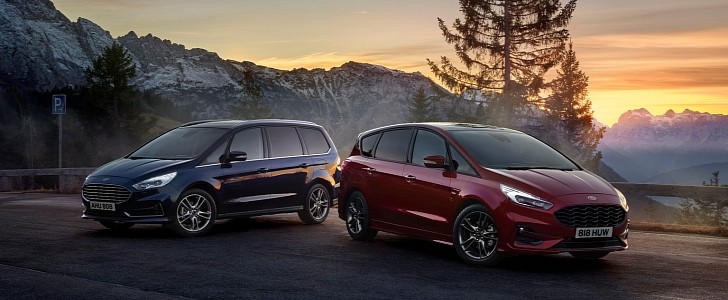While at home in America, Ford is continuously moving away from passenger cars towards a business strategy focused (with minor exceptions) on crossovers, SUVs, and trucks, the situation is a bit different on the Old Continent. In Europe, the U.S. automaker still builds minivans such as the S-Max and Galaxy, and is apparently not ready to give up on people movers just yet.
Of course, it’s also trying to bend the genre to suit its momentary needs. For example, Ford recently premiered the new S-Max Hybrid, and the seven-seater is being carefully labeled as a “sports activity vehicle.” The company also introduced alongside it the Galaxy Hybrid, which is being depicted as a people mover that brings “first class refinement” alongside the newly minted full hybrid powertrain.
Speaking of the latter, the gas-electric assembly features a combination of a 2.5-liter Atkinson cycle gas engine and an electric motor that extracts energy from a modern 1.1 kWh lithium-ion battery. It’s a traditional hybrid setup, so don’t expect plug-in recharging capabilities or too many miles in EV mode. Ford doesn’t even advance a figure, instead claiming the setup will smartly deploy the electrical power to help achieve better fuel efficiency.
As far as the S-Max Hybrid is concerned, the new powertrain is touted as capable of reducing by at least 10% the CO2 emissions produced by the equivalent EcoBlue diesel version, according to WLTP standards. Performance isn’t neglected, though, with the S-Max Hybrid and Galaxy Hybrid packing 190 PS (187 hp) and the former being capable of reaching 100 kph (62 mph) from a standstill in 9.8 seconds.
Best of all, the S-Max and Galaxy Hybrids (both available for order and with production scheduled to kick off in Valencia, Spain) remain just as practical as before. Both feature easy to configure seating arrangements, as well as ample loading capacity. For example, with all seven seats in place, the S-Max still has 285 liters (10 cu ft) of cargo capacity - 300 liters (11 cu ft) for the Galaxy Hybrid.
Maximum available capacity reaches up to 2,200 liters (78 cu ft) for the S-Max and 2,339 liters (83 cu ft) for the Galaxy, while the towing capacity varies between 1,560 kg (3,439 lbs) and 1,750 kg (3,858 lbs), depending on the seating capacity.
Speaking of the latter, the gas-electric assembly features a combination of a 2.5-liter Atkinson cycle gas engine and an electric motor that extracts energy from a modern 1.1 kWh lithium-ion battery. It’s a traditional hybrid setup, so don’t expect plug-in recharging capabilities or too many miles in EV mode. Ford doesn’t even advance a figure, instead claiming the setup will smartly deploy the electrical power to help achieve better fuel efficiency.
As far as the S-Max Hybrid is concerned, the new powertrain is touted as capable of reducing by at least 10% the CO2 emissions produced by the equivalent EcoBlue diesel version, according to WLTP standards. Performance isn’t neglected, though, with the S-Max Hybrid and Galaxy Hybrid packing 190 PS (187 hp) and the former being capable of reaching 100 kph (62 mph) from a standstill in 9.8 seconds.
Best of all, the S-Max and Galaxy Hybrids (both available for order and with production scheduled to kick off in Valencia, Spain) remain just as practical as before. Both feature easy to configure seating arrangements, as well as ample loading capacity. For example, with all seven seats in place, the S-Max still has 285 liters (10 cu ft) of cargo capacity - 300 liters (11 cu ft) for the Galaxy Hybrid.
Maximum available capacity reaches up to 2,200 liters (78 cu ft) for the S-Max and 2,339 liters (83 cu ft) for the Galaxy, while the towing capacity varies between 1,560 kg (3,439 lbs) and 1,750 kg (3,858 lbs), depending on the seating capacity.
















